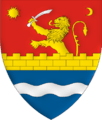Gottlob, Timiș
| Gottlob | |
|---|---|
| Commune | |
 Gottlob | |
| Coordinates: 45°56′N 20°43′E / 45.933°N 20.717°ECoordinates: 45°56′N 20°43′E / 45.933°N 20.717°E | |
| Country |
|
| County |
|
| Government | |
| • Mayor | Gheorghe Nastor (PNL) |
| Area | 32.29 km2 (12.47 sq mi) |
| Population (2011) | 2,041 |
| Time zone | EET (UTC+2) |
| • Summer (DST) | EEST (UTC+3) |
Gottlob (German: Gottlob; Hungarian: Kisősz) is a commune in Timiș County, Romania. It is composed of two villages, Gottlob and Vizejdia (Wiseschdia; Vizesd). These were part of Lovrin Commune until 2004, when they were split off.
Etymology
The commune's name is of German origin, with the meaning of "Praise to the Lord".
History
The village was founded between 1770 and 1773 and entailed 203 houses. The Catholic parish was also founded in 1773. The majority of the population was Catholic until the 1940s.
Until 1967 Gottlob was a commune, but due to the dwindling population it was demoted to village level without its own administration and incorporated in the Lovrin commune. In 2003 Gottlob received again commune status and has since elected its own mayor.
The Germans (Banat Swabians) formed until 1940 the majority of Gottlob's population (1910: 91%). After the war, the ethnic composition of the local residents changed decisively - the number of German residents fell from 1,836 in 1910 to 875 in 1977, representing only 38% of the residents. This trend has continued and led to a number of only 160 Germans in 1991 and 98 in February 1996. Main reasons are the migration to Germany either immediately after the Second World War or during the Communist regime. Another wave of emigration took place after the opening of borders at the beginning of the 1990s.
The exodus of residents left Gottlob to the situation where only one in three or four houses is inhabited.
Until 1992, Gottlob had a German school and a German kindergarten, but they were closed due to lack of pupils. The Romanian school in the village remained the sole institution responsible for education.
The local church was built in 1867 and lavishly decorated through donations by the rich congregations of the village. The ceiling paintings and the altar were cared of for well over a hundred years. Several sculptures of saints have been specially cared of by local families, which constituted a special honor. Parts of the church furnishings were stolen or destroyed during the 1990s. A renovation of the exterior facade succeeded the late 1990s by donations from Germany.
In 1994 a memorial stone was unveiled in the local cemetery. The inscription on the memorial stone reads:
- Den Toten zum Gedächtnis, den Lebenden zum Vermächtnis
- 1939 - 1945 gefallene Helden 52
- 1945 - 1949 Rußlandverschleppung 17 Tote
- 1951 - 1956 Deportation in den Baragan 9 Tote
- Ruhet sanft! - Gemeinde Gottlob
- "In memory of the dead, legacy to the living
- 1939 - 1945 Fallen heroes 52
- 1945 - 1949 Expulsion to Russia 17 dead
- 1951 - 1956 Deportation to the Bărăgan 9 dead
- Rest in peace! - Commune Gottlob"
Gottlob today
Nowadays the Romanian majority shapes Gottlob's cultural image. The first church consecration was held on 3 November 1996 and was accompanied by a costumed parade.
The former state-owned station for the mechanization of agriculture (SMA) was divided after 1989 into several companies who farm the land of the village and neighboring communes. The old premises of the station fell into disrepair.
The medical care of the residents deteriorated in 2003 when the village doctor resigned and devoted himself to agriculture because it is a more lucrative business.
| Wikimedia Commons has media related to Gottlob, Timiş. |
